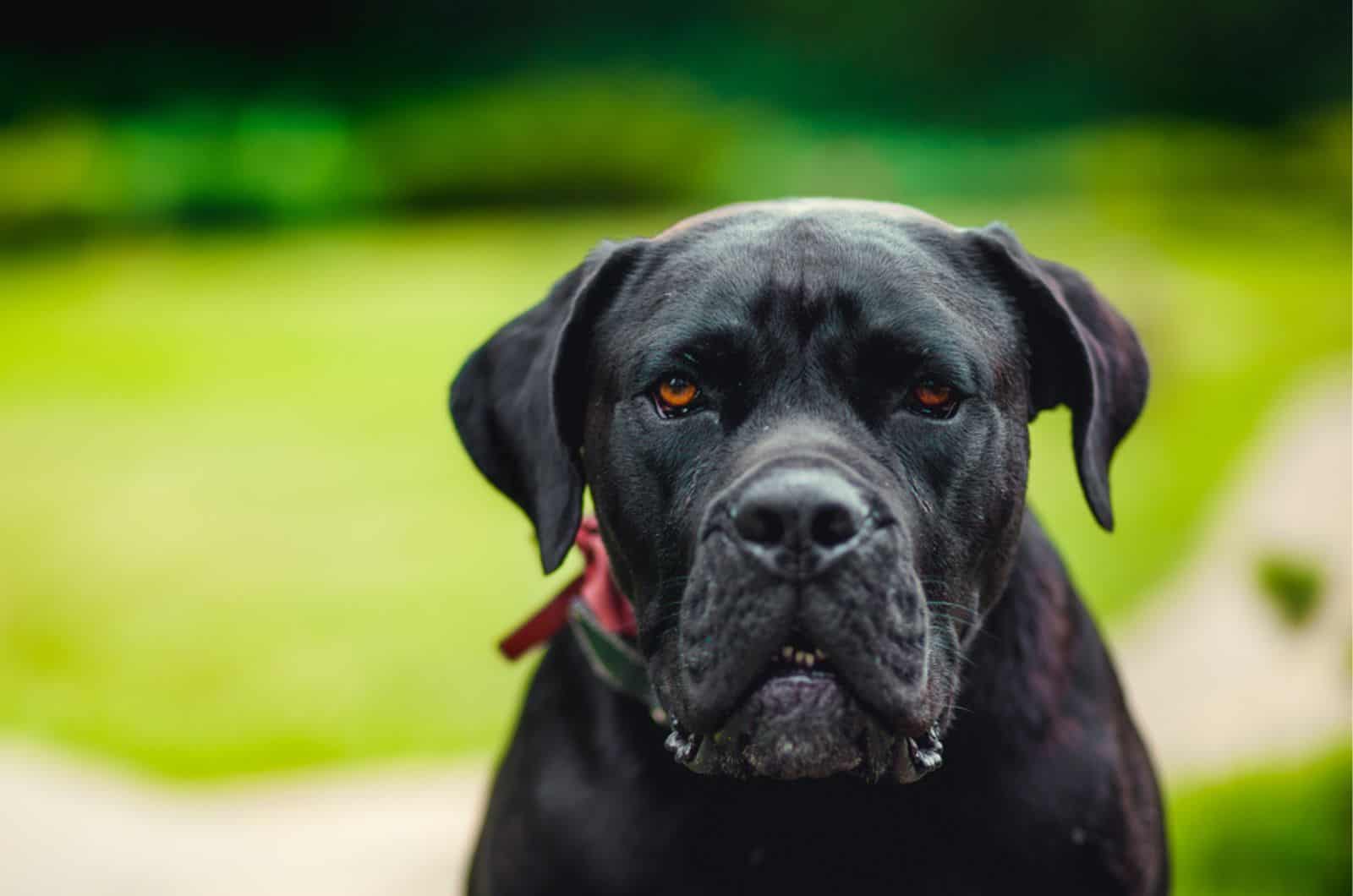Something about a black dog makes it that much more elegant and appealing. It is particularly the case with those breeds that commonly do not have a natural occurrence of that color within their breed standards.
Black American Bulldogs are uncommon among breeders, and we will find out exactly why. However, the topic at hand, what makes the American Bulldog black, focuses on the way it looks and behaves first and foremost.
With a steady rise in popularity, the American Bulldog with a black coat is worth talking about, and there is a lot to say on the subject of appearance, behavior, and genetics.
For all those who like to know more about how coat colors in dogs are determined, there is a section dealing with the genetics of the Black American Bulldog towards the end.
Welcome to the black American Bulldog profiling session.
Black American Bulldogs Are Real And Here Is How They Look
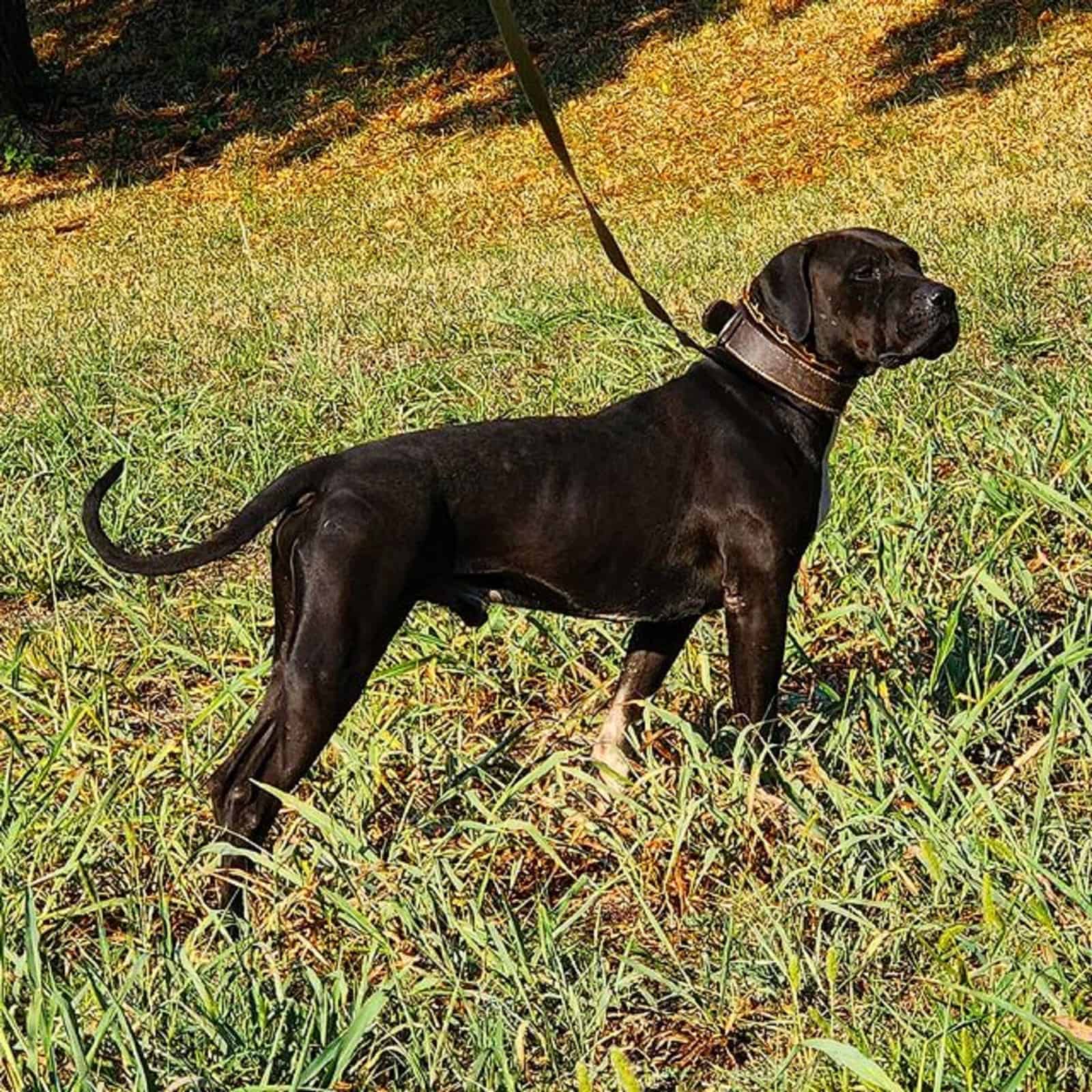
Thanks to some genetic acrobatics, the black American Bulldog deviates from the usual breed colors and patterns. Although most other combinations involve at least ten percent white coverage, the black American Bulldog is completely black.
Since all of the color combinations involve some white markings, a solid black coat in the American Bulldog really catches the eye. There is a possibility of expressing some markings on the chest, neck, between the eyes, and the paws, but our interest is in the solid black version.
There Is More To Looks Than The Coat
In terms of other physical features, they follow the conventions of all other American Bulldogs. Males are between twenty-two and twenty-five inches tall and weigh seventy-five to one hundred pounds.
Females reach weights of sixty to eighty pounds and grow anywhere between twenty and twenty-three inches in height. With a body length that barely exceeds its height, the American Bulldog carries a lot of muscle and has thick bones.
American Bulldog puppies can often be overfed due to their immense appetite, so tracking their progress is key. Consider using an American Bulldog growth chart to see if your pup is within the healthy range of weight and height.
Although it is related to the English Bulldog, it is significantly taller and more substantial in mass. The athletic body of an American Bulldog was designed for work, so the head is wide, with a muzzle proportionate to it.
The small to medium triangular ears are spread wide and hang facing forward. When alert, they are level with the eyebrows or just under the eyebrow line.
A strong reverse-scissor bite is possible thanks to a moderately thick neck that connects to well-developed shoulders and a deep-seated chest. The feet and leg bones are perpendicular to the ground without any arching.
There is a slight tuck of the loin that accentuates the muscular hind legs. The back is straight except for a small slant at the lumbar spine (lower back). When resting, the dog’s tail should hang but not straight down. An alert American Bulldog’s tail should be level with the back.
There Are Two Types Of Black American Bulldog
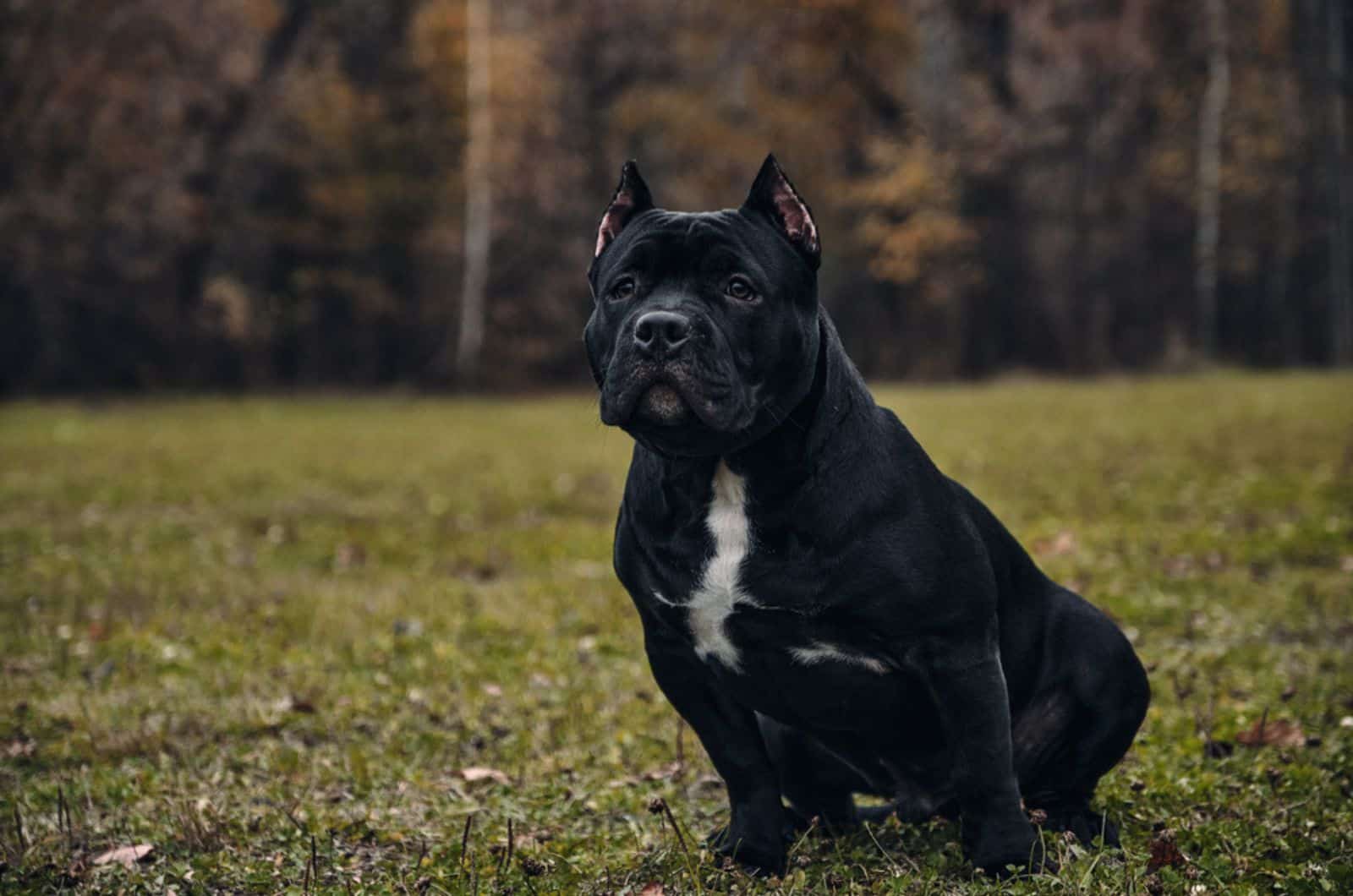
Historically, the American Bulldog of the eighteenth century went by different names, such as Old English Bulldog, English White, Southern Bulldog, etc. The only thing that did not change was the Bulldog part.
The United Kennel Club, UKC, recognizes two strains of American Bulldog — the Johnson type and the Scott type. Nowadays, the Scott is called “standard”, while the Johnson is known as the “American bully” type.
When it comes to differences, they are mainly in physical appearance, but the temper is slightly different too. The Scott type has thinner bones, less muscle mass, and is of a slightly smaller body frame.
A Johnson type will have a wider skull, shorter muzzle, and more pronounced stop. This type was preserved as a working dog, so it makes sense that it is the more powerful of the two. The Scott type is considered a show dog due to its more elegant silhouette.
Differing Aspirations
In terms of temperament, both dogs have the same protective instincts and unwavering loyalty and affection for the family. They are the utility dog for any home with farm work to be done. The color for the Johnson type is far less important as long as it does not affect its working ability.
Although both types are admirable working dogs with great strength, the bully dog is preferred for people who own cattle and need protection from wild animals, with the Scott type being the more popular choice as a family pet.
Keep in mind that many a modern American Bulldog is the product of these two separate lines that makes them American Bulldog mixes.
If you like stories of breed lineages that result in subtle variations in physical appearance and temperament, I recommend you read our articles on Gator and Razor Edge Pitbulls.
Coat And Grooming
Both types have the same smooth, short coat that requires almost no effort to groom. The quality of the coat can be soft or stiff, with the latter being more common in the Johnson type American Bulldog.
They are low to moderate shedders, but the peak periods of hair-rich homes come with the seasonal coat change. Brushing them once or twice a week should be enough to maintain that hair shine and remove the excess hairs.
Since their coat length and quality is similar to that of the Pitbull, this article on Pitbull shedding potential and more will certainly be of help. For a hair-free festive period, Santa put some tips and tricks on stopping Sheddmageddon in your sock.
Essential Information On The Black American Bulldog’s Temperament
Large breeds such as the black American Bulldog and its differently colored purebred counterparts are dominant dogs. Regardless of their best friend potential for family members, strangers can be a point of concern for them.
If you live in an apartment and there are no cattle to manage or intruders to ward off, the high energy levels of the American Bulldog will have to be spent in some other way.
Out of the two most well-known types, the Scott and Johnson, the bully breed will be more individualistic and focused on work, while the standard type has a more laid-back approach to life. That is not to say the bigger version does not enjoy the occasional cuddle.
An American Bulldog will not bark a lot unless there is a black French Bulldog in the house that reminds it of what it would look like in a compressed black coat format.
The standard type will be a tad more responsive to dog training, but both can be trained to do most things other dog breeds of similar type can do. Of course, the American Bulldog will not be as trainable as an American Staffordshire Terrier or the American Pitbull Terrier.
Socialization
The challenging nature of the American Bulldog, no matter the coat color, can be kept in check if the dog receives proper socialization from puppyhood. During the “teen” years, they will require a firm hand to teach them correct behavior.
One of their favorite pastimes is a game of tug-of-war, which will prove to be a good strength exercise for both you and your doggie. If you have other dogs in your home, the American Bulldog will be a good roommate, but only if raised alongside them.
You do not need to worry about their temperament around young children. They will be protected, and the sizeable lump of a dog will be very gentle with them. Just make sure your kids know how to understand dog behavior and signals that it does not want to be bothered.
Small animals like rabbits, guinea pigs, hamsters, etc., should not have too much trouble living freely around the American Bulldog. If you have the occasional deer, raccoon, or badger visit your home, then they might get the pointy end of the stick.
Black American Bulldog Health Problems, Life Expectancy, And Food
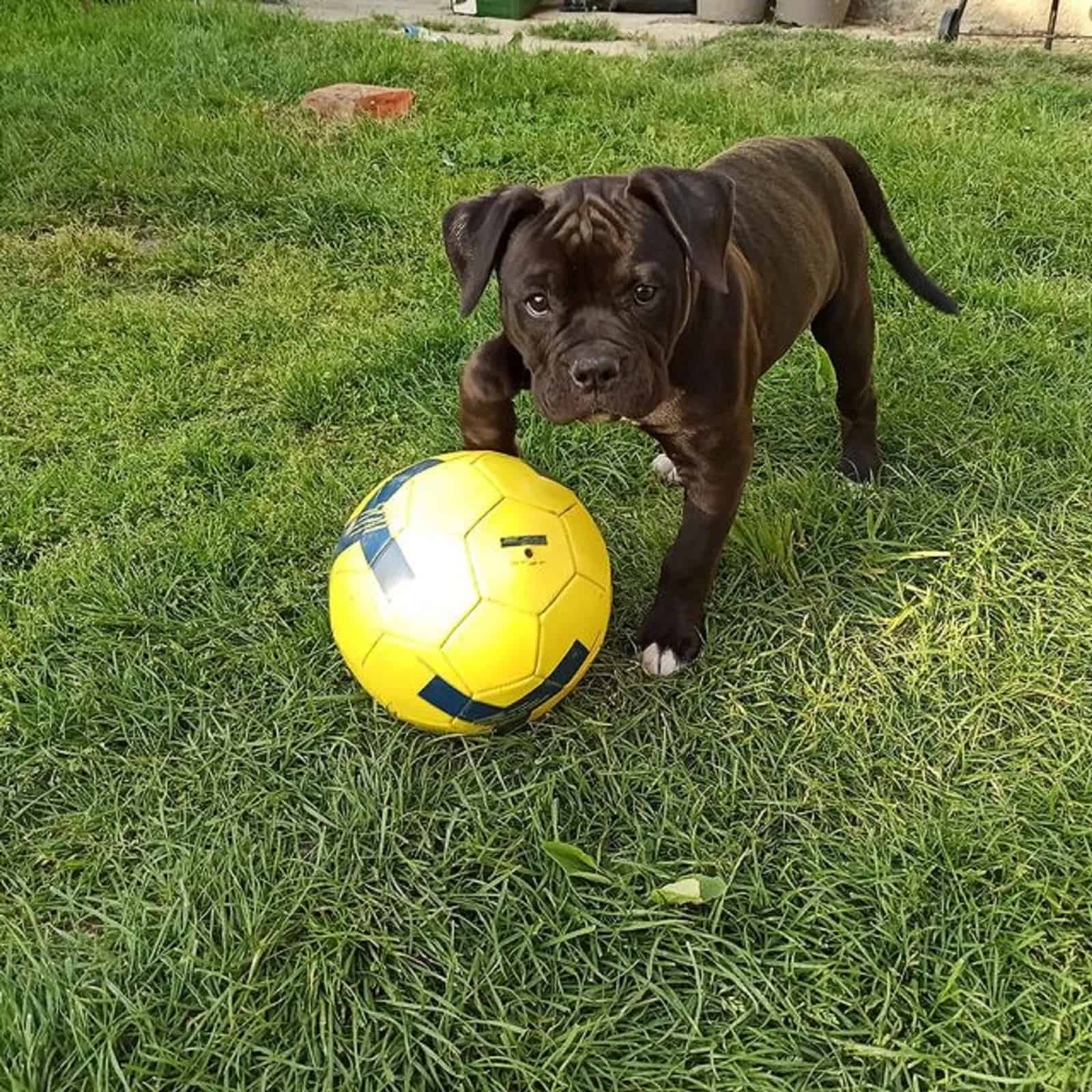
Genetic diseases in many dog breeds can be a source of worry for prospective dog owners. For the black and other American Bulldog colors, there are potential congenital issues stemming from genetic mutations specific to the breed.
A quick look into those will provide a more realistic portrait of what to expect when considering getting one, so let us start off with the ones most associated with the American Bulldog breed.
Canine Neuronal Ceroid Lipofuscinoses (CNCL)
Characterized as a set of debilitating progressive neurodegenerative diseases, neuronal ceroid lipofuscinoses are a serious genetic mutation that was discovered to affect as many as thirteen genes.
Depending on which gene is affected, treatment and prognosis differ, but symptoms often overlap. The only viable diagnosis that can tell with certainty which gene underwent mutation is a DNA test.
Symptoms include loss of motor function, difficulty breathing and swallowing, cognitive decline, loss of vision, and seizures. Because only one form of CNCL has somewhat effective treatment, the prognosis is usually premature death.
For the one treatable type, a gene found in the Dachshund was used as a model on which to test different hormonal and enzyme therapies.
Hypothyroidism
A stunted production of thyroxine and triiodothyronine by the thyroid gland is called hypothyroidism. It can be caused by a tumor or have an autoimmune-mediated origin.
In dogs, the latter is responsible for over ninety percent of cases of hypothyroidism. The immune system mistakes the cells of the thyroid as foreign bodies and, in the process of defending the body, it neutralizes them.
With the damage to structural and functional parts of the thyroid, the production of hormones is reduced, often leading to major clinical signs. Those include lethargy, weight gain without increased appetite, degrading coat quality, increased heart rate, metabolism changes, etc.
With varying degrees of severity, hypothyroidism affects nutrient absorption, body temperature control, and cognitive function in very severe cases. Although incurable, synthetic hormone therapy is an effective treatment.
Entropion
In simple terms, entropion is when a dog’s eyelid grows inward. This is mostly a congenital disease inherited from the parents, but there have been cases where entropion was caused by injury.
It is not a serious condition, and the symptoms are easy to spot. Your dog might have discharge or pus coming out of the eye, increased production of tears, and keep its eye closed eye most of the time. The main symptom, however, is when you see your dog’s eyes become red.
Still, there are many other reasons why your dog’s eyes might be red, and this symptom alone will not be enough to diagnose entropion. A full physical examination by a vet will give a final clinical picture and concrete diagnosis.
Thankfully, the treatment is a routine surgery that involves restoring the skin around the eyelids to its natural and anatomically correct position. Puppies and adult dogs have different kinds of surgery because puppies do not have fully developed faces yet.
American Bulldogs are more prone to the congenital variant of entropion due to the shape of their skull, eyelid length, or other anatomical factors.
Cherry Eye
Dogs and many other animals have a third eyelid that has a protective and functional role. It shields the eye from debris and produces watery content for eye lubrication. Cherry eye simply indicates that the gland is protruding due to inflammation.
The protrusion occurs when the tissue connecting it with the lower eyelid detaches. American Bulldogs are among the breeds that are more susceptible to cherry eye, but it is not exclusive to it.
Cherry eye is easy to diagnose since the protruding nictating membrane (their third eyelid) looks like a cherry. It will present itself as a swollen red mass and will usually be confined to the corner of the eye.
Surgery of the gland is the treatment for it, and it is important to take your dog to the vet as soon as you notice a red mass in the corner of the eye. If left untreated for a prolonged period, it can swell further and cause more damage to the structural elements of the eye.
Hip And Elbow Dysplasia
Everyone and their dog knows about dysplasia. Large breeds are particularly susceptible to it due to the speed of their offspring’s growth. It is an inherited condition that causes the head of the femoral bone (ball) not to develop fully.
Without a perfect fit into the hip bone (socket), the cartilage between the two bones that provides cushion and smooth movement will become damaged and eventually completely wear off.
The ball and socket will grind against each other, scraping the tissue and causing inflammation. Ultimately, the dog is going to develop arthritis, which means pain and difficulty moving.
Non-steroid anti-inflammatory drugs are used to alleviate the pain. Still, in more serious cases where the dog’s movement is impaired, ostectomy and hip/elbow replacement are the only options.
Life Expectancy And Food
For a large breed dog, the black American Bulldog (and all the other shades of it) is quite healthy. On average, you will share your home with one for ten to twelve years. Extending your dog’s life to the maximum can be done through regular exercise and feeding it high-quality dog food.
Since the American Bulldog is prone to obesity, you should keep calories in check. The American Bulldog feeding chart is the perfect tool that can help you come up with a healthy diet for your dog.
Do not give your dogs treats as a “free meal”. Every single treat must be accounted for in the daily calorie limit.
Whether you choose to feed it high-quality kibble, wet food, home-cooked, or raw diet, it is important to manage the weight. Protein should take up most of the meals, with fatty acids (omega-3, omega-6, and omega-9) and vitamins and minerals filling out the rest.
If you like the prospect of a raw diet, check out our American Bully raw diet article. Being similar in size and with some common lineage, you can apply the same principles to your American Bulldog.
Quick Genetic Breakdown Of A Black American Bulldog’s Coat
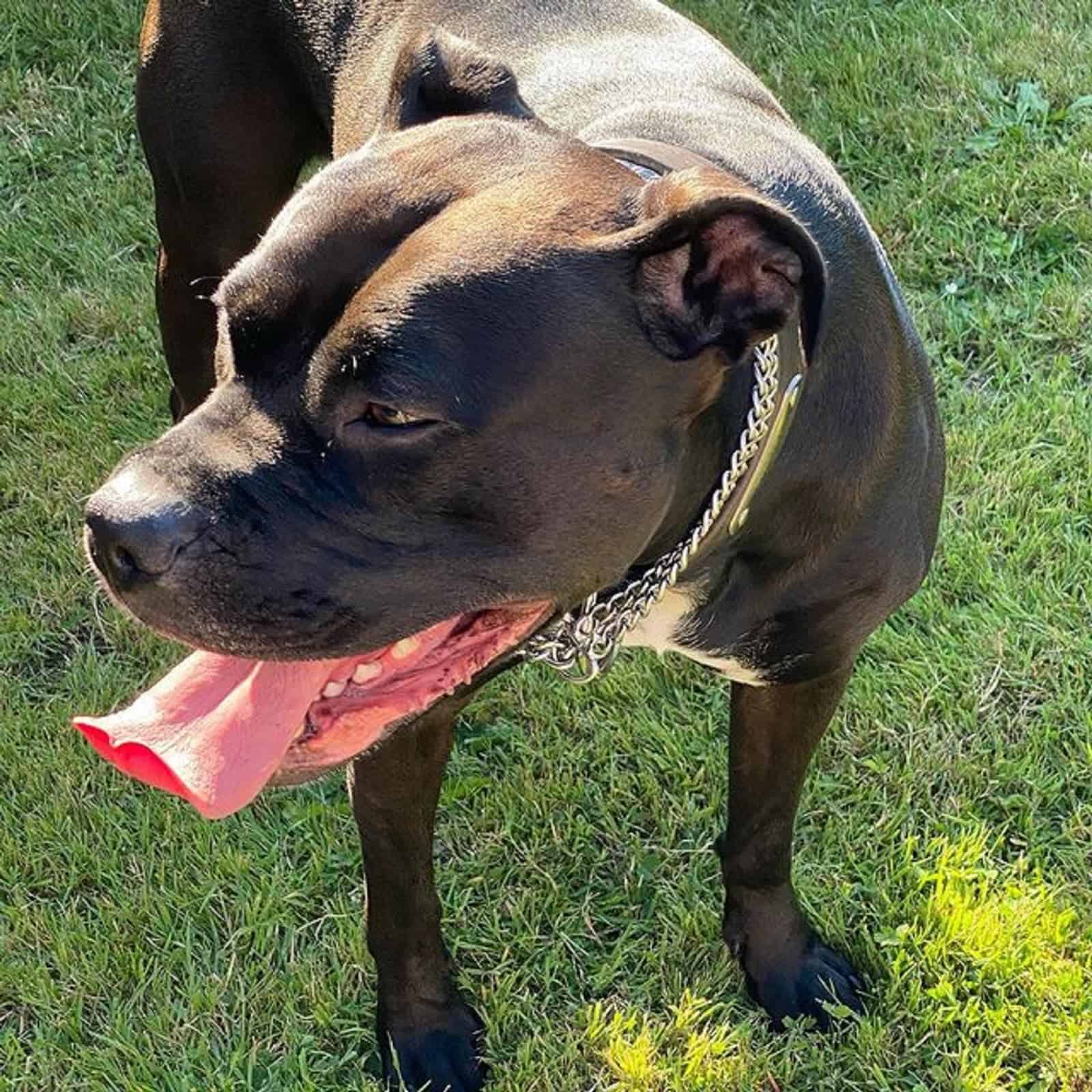
The mixture of the only two pigments in a dog’s body, black and red, yields all of the possible coat color results. With a black American Bulldog, the pigment story is slightly more complicated than “it was black pigment”.
Alleles (gene variants) found on specific loci (locations on a chromosome) give instructions on how and where the pigments will be produced. For the black American Bulldog, the first locus where a decision has to be made is the E locus.
Here, the decision of whether black pigment (eumelanin) will be allowed production is made. If there is at least one dominant gene found on the E locus, eumelanin will be produced. Next stop — the K locus.
Black is the dominant color on the K locus, but the black in the American Bulldog is not produced by it. Two recessive genes are required for the decision to be passed onto the A locus.
Keep in mind that a brindle American Bulldog has a brindle allele on the K locus, which is the second most dominant gene on it. This allele is the endpoint for the striped version of an American Bulldog’s coat color journey.
From A To B
Since the most common colors and patterns in the breed are determined by the A locus, the black American Bulldog has to carry two recessive genes on it. Usually, it would be white and some other marking color or fawn, but a recessive pairing is required for the full black coat.
The A locus, or ASIP protein, controls the production and distribution of black and red pigment on a dog’s coat. Thanks to the wide variety of interactions of the A locus with other loci, we see different patterns and colors in most American Bulldogs.
A black American Bulldog will have a combination of a/a on this locus, giving the B locus the responsibility of deciding whether the dog will be black or brown. One dominant gene (B) is enough to tip the scale in the favor of eumelanin, giving the dog a solid black coat.
Black American Bulldog FAQ
Not many American Bulldog breeders will breed dogs with solid black coats. Since it is not desirable for a show dog to be fully black due to the breed being predominantly white (the rule is that at least fifteen percent white is required to be able to participate in conformation events).
If the breeder does have black American Bulldogs, then a DNA test to rule out genetic diseases is necessary. If everything checks out, and the dog has a clean bill of health in addition to a good pedigree, you are looking at around $2500 and $3500 for a black American Bulldog.
Indeed, it is a steep price, but the amount of dog you are getting is more than worth it. Always be mindful of ads selling American Bulldog puppies for ridiculously low or high prices. This is most often the mark of a backyard breeder or a puppy mill.
This is particularly the case for French Bulldog puppies, as they are the most wanted designer dog breed in the US.
Another thing to note is that a black American Bulldog is not eligible for conformation shows. The American Bulldog Association (ABA) and United Kennel Club (UKC) will not allow you to show your dog as it is not according to breed standards to have a solid black coat.
The Pitbull is a mix of the American Staffordshire Terrier and various other breeds from the terrier family of dogs. On the other hand, the American Bulldog is considered to be a purebred dog that has its roots in the mix of the English Bulldog and domestic dogs from the US south.
Even today’s protagonist and its small cousin can be mixed with success with a Pitbull. That is why the French Bulldog and Pitbull or the American Bulldog and Pitbull mixes are so popular.
You can find out more about their difference in our American Bulldog Vs. Pitbull article!
Note that the American Kennel Club (AKC) does not recognize American Bulldogs as a distinct breed, so you are stuck with your dog participating in very few events, which mostly include work-oriented challenges.
Summary
Having reached the end, I only have two things to say. Black American Bulldogs are incredible dogs. Despite the breed standards, color should not play a major role in its temperament.
Breeding dogs with recessive genes is a concern, but largely unfounded and lacking concrete evidence in the case of recessive black genes. If the breeder selling black American Bulldogs can provide adequate DNA test results and bloodline records, then the color makes no difference.
Liking a dog for its color is not desirable, but if you like the dog first, the black coat will only be a bonus. Most importantly, stay away from shady discounts and dodgy ads to avoid paying thousands of dollars in vet bills.
Stay smart, stay informed, and I will write to you in the next one.
